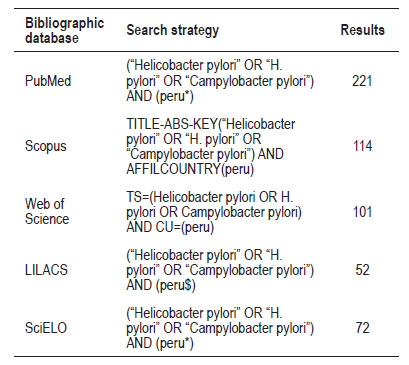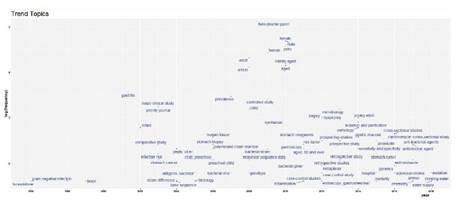INTRODUCTION
Helicobacter pylori (H. pylori) initially known as Campylobacter pylori, is one of the bacterial pathogens that most frequently colonizes the gastrointestinal tract of humans, considering that it is found in more than half of the world population 1. Its discovery, 38 years ago, revolutionized medicine by being the first bacteria with carcinogenic properties formally recognized 2.
H. pylori infection is a key factor in the pathogenesis of various gastrointestinal diseases such as chronic gastritis, peptic ulcer, gastric adenocarcinoma, and lymphoma 1,2, hence the importance of its study for the control of various clinical conditions.
From the description of this bacterium in 1992, there has been an increase in the studies published worldwide on this pathogenic agent, motivated by the importance that this microorganism represents for Public Health 3. For this reason, the number of publications related to H. pylori has progressively increased, with the approaches evolving based on the knowledge acquired 3,4. In this regard, in recent decades, various studies have been using bibliometric methods to evaluate scientific productivity in various biomedical fields, the study of scientific production in the field of gastroenterology and specifically in H. pylori 1,2,5,6.
In Peru, various series describe prevalence of H. pylori greater than 30%, postulating that infection by this pathogen is acquired in the early stages of life and that it would be higher in groups with a lower socioeconomic level 7-9. However, to date, there are no studies on the Peruvian scientific production in H. pylori. The study of the scientific production of a country on a health topic is important to know the state of research development in a specific area and to identify opportunities to direct the research according to the needs of the country. Therefore, the objective of this bibliometric analysis was to evaluate the Peruvian productivity, in original articles published until 2019, on H. pylori, considering the quantity and quality of the published articles, as well as an analysis of citations by authors and co-occurrence of terms in documents. This analysis has the purpose of determining whether or not there has been an increase in publications on H. pylori by evaluating the Peruvian scientific production regarding this pathogenic agent.
MATERIALS AND METHODS
Study design
A bibliometric analysis of original articles on Helicobacter pylori in journals indexed in PubMed, Scopus, Web of Science (WOS), LILACS, and SciELO was carried out.
Data source
The bibliographic databases PubMed, Scopus, and WOS were used, given that they collect the largest number of indexed journals in the health field. Likewise, the bibliographic databases LILACS and SciELO were used since they index journals from countries in the Latin American and the Caribbean region, such as Peru.
PubMed is an open-access search engine, offered by the United States National Library of Medicine, which allows access to abstracts and references of biomedical research articles contained in Medline (the most widely used open access citation database), and additionally in a variety of scientific journals not included in this database, but of similar quality 10. Scopus is a bibliographic database published by Elsevier and accessible by subscription, contains abstracts and citations of scientific articles from more than 16,500 journals (including all Medline documents) and information, author profiles, and details of the citations that each published document has received. The data offered by Scopus are useful for quantity and quality measurements in studies that evaluate institutional scientific production 11. WOS is an online scientific information service, integrated into ISI Web of Knowledge; allows access to a set of databases to access documents that cite different scientific articles, as well as access to previous publications of research through their bibliographic references; in this way, the impact of scientific work can be evaluated 12. LILACS is a bibliographic database supported by the Latin American and the Caribbean Center for Information on Health Sciences (BIREME) of the Pan American Health Organization and World Health Organization, which contains more than 900 thousand records of journal articles, peer-reviewed theses and dissertations, government documents, conference papers, and books from the Latin America and the Caribbean region 13. SciELO is a bibliographic database of open access journals from the Latin American and Caribbean region with more than 1,000 indexed journals and a collection of more than 400,000 articles from this region 14.
Search strategy
The search strategies used were developed on September 8, 2020, following the search strategy developed by Taype-Rondán et al. 15. The search strategies included controlled and free terms to be searched in the title, abstract, and keywords of the documents indexed in PubMed, Scopus, WOS, LILACS, and SciELO. In Table 1, the search strategies used for each of the databases are presented. The review and selection of the retrieved articles were carried out by two authors (GBQ and ABP) independently.
Identification of original articles
The complete records of each publication retrieved in the searches in each bibliographic database are downloaded as .csv or .ris files and imported into EndNote X9 for the identification and elimination of duplicates following the methodology of Bramer et al. 16. Subsequently, the publications were imported into Rayyan (https://rayyan.qcri.org), where two authors (GBQ and ABP) selected the articles that met the inclusion criteria: be original articles whose main topic was on H. pylori or that the measurement of data on H. pylori be identified in the title or abstracts, that at least one researcher has a Peruvian institutional affiliation and has been published until 2019. It was considered to include only articles published until 2019 because the year 2020 is still in progress, and the numbers of the journals during this year, in many cases, have been affected in their publication times due to the COVID-19 pandemic.
Bibliometric analysis
The VOSviewer software (Leiden University, Leiden, The Netherlands) was used to develop bibliometric networks based on co-authorship, using the information on the names of the authors associated with the original articles retrieved from the total bibliographic databases used.
The Biblioshiny and Bibliometrix packages were used in the R programming language to obtain bibliometric indexes. For this analysis, only the original articles retrieved from Scopus were used, since Bibliometrix R-package uses the data reported by Scopus for each document retrieved in order to calculate bibliometric indices.
Prior to the analysis, one of the authors (AHV) performed a manual standardization of the author’s name and affiliation domains, since documents with erroneous attribution of these data were detected. As results of this analysis, the average number of publications per author, number of publications with one or more authors, average number of authors per article, average number of citations per article, number of original articles were reported, as well as the following bibliometric indexes: index of authors per article (ratio between the total number of articles and the total number of authors), co-author index per article (average number of co-authors per article) and the collaboration index (ratio between the total number of authors of articles with several authors / total articles with several authors). More information on the calculation of these bibliometric indices is available on the Bibliometrix website ( http://www.bibliometrix.org/).
For the analysis of co-occurrence of terms in titles and abstracts of the original articles retrieved from Scopus, the Biblioshiny and Bibliometrix packages in the R programming language (Bibliometrix R-package) were also used. A threshold for the co-occurrence of terms in titles and abstracts of five mentions was used, with terms that did not have at least five mentions in the total of articles were excluded.
RESULTS
After eliminating duplicates, data from 289 publications (PubMed: 221, Scopus: 114, WOS: 101, LILACS: 52 and SciELO: 72) were analyzed. Of these publications, 180 (64.36%) were original articles published until 2019, which were included for the analysis. In general, an increase in Peruvian scientific production was found in original articles on H. pylori (R2 = 0.64), with an average annual growth rate of 8.01% (Figure 1).
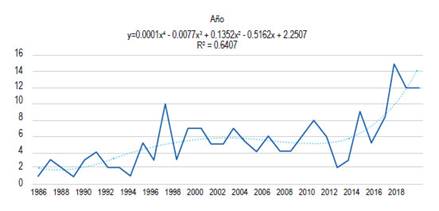
Source: PubMed,Scopus, Web of Science (WOS), LILACS, and SciELO databases.
Figure 1 Scientific production of original articles on Helicobacter pylori from Peruvian institutions.
As part of the bibliometric analysis, 777 authors were found in original articles on H. pylori found in the five bibliographic databases included. An average of the number of articles per author of 0.23 was found. The authors with the highest number of publications were Gilman RH (45 articles), León-Barua R (23 articles), Cok J (22 articles), and Bussalleu A (22 articles). In Figure 2, the co-authorship analysis in VOSviewer is presented, evidencing the formation of collaboration networks around the authors with the highest scientific production previously described.
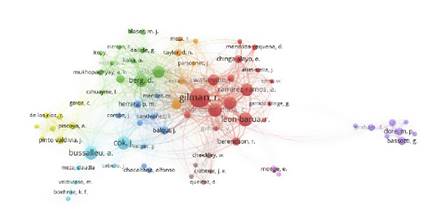
Source: PubMed, Scopus, Web of Science (WOS), LILACS and SciELO databases.
Figure 2 Author co-authorship analysis Peruvian scientific production on Helicobacter pylori.
Regarding the institutional affiliations of the authors of the publications on H. pylori, the analysis carried out with the Biblioshiny and Bibliometrix packages of original articles recovered from Scopus, found that the Universidad Peruana Cayetano Heredia was the most frequent institutional affiliation with 55 (63.2%), followed by Johns Hopkins University with 30 (34.5%) articles, and Washington University with 13 (14.9%). Regarding collaboration networks, it was found that the greatest collaboration of Peruvian institutions occurred with institutions from the United States, also including collaborations with European and Latin American institutions (Figure 3). Likewise, it was found that the original articles retrieved from Scopus had an average number of citations of 1.91, being the documents of Kelin PD et al. and Aspholm-Hurtig M et al., presented the highest number of citations (466 and 274, respectively), with an average citation per year (15.53 and 16.12, respectively)
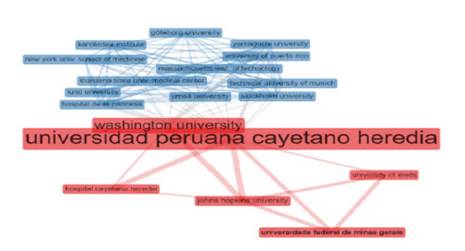
Figure 3 Worldwide institutional collaboration networks in original articles on Helicobacter pylori that included at least one Peruvian institutional affiliation.
In relation to scientific journals, in the analysis of the total original articles retrieved from the five bibliographic databases included, it was found that about half of the publications (47.85%) were published in the seven journals with the highest number of original articles. On the other hand, the Revista de Gastroenterología del Perú, with 55 original articles (29.57%), published the highest number of publications on H. pylori, followed by the Journal of Clinical Microbiology with seven (3.76%), Acta Gastroenterológica Latinoamericana with six (3.23%) and the American Journal of Gastroenterology with also six publications (3.23%) (Table 2).
Table 2 Top ten journals publishing Peruvian scientific production on original articles about Helicobacter pylori.
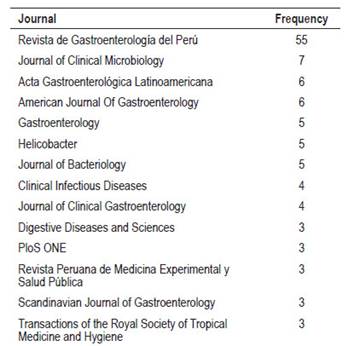
Source: PubMed, Scopus, Web of Science (WOS), LILACS, and SciELO databases.
Regarding the analysis of co-occurrence of terms (Figure 4), in mid-2000, where an increase in the number of articles on H. pylori was evidenced, terms such as stomach cancer, stomach biopsy, human tissue, prevalence, polymerase chain reaction, strain difference, molecular sequence data, and bacterial strain. For recent years, terms such as drinking water, water supply as well as clarithromycin, metronidazole, anti-bacterial agents, and anti-infective agents have been found. In general, the terms in relation to gastric cancer have been maintained during the years of study.
DISCUSSION
Evaluating the scientific production of a country on a health topic makes it possible to identify the state of scientific production and guide the development of future research. This study aimed to determine the Peruvian scientific production in H. pylori and its characteristics. As results, there is evidence of an increase in the number of original articles on H. pylori by authors with Peruvian institutional affiliation during the last decades, identifying institutions that lead research on H. pylori in Peru, inter-institutional collaboration networks, and thematic on H. pylori that have been more studied in recent years.
Regarding the Peruvian production in publications on H. pylori, in the study period, an increase in the number of original articles published was evidenced. In line with this, various previously published bibliometric studies indicate an increase in scientific production on H. pylori from previous decades 1,2,5. Given the need to promote research for decision-making and development of strategies for disease control, the increase in the original production of H. pylori describes a scenario in which knowledge is being generated for a greater understanding of the problem of H. pylori.
In recent years, a boost has been given to research from the Council of Science (CONCYTEC) of the Government of Peru, including training in research for professionals in national territory and abroad, including those in science and health, as well as financing for the development of research through competitive funds with the participation of public institutions and international institutional collaboration 17,18. These government measures could help sustain the growing Peruvian scientific production of H. pylori over time, useful for the study of this high-frequency pathogen in the Peruvian population.
In relation to institutional affiliations, it was found that the most frequent institution publishing original articles about H. pylori was the Universidad Peruana Cayetano Heredia. This institution is one of those that lead the scientific production in Peru, and, specifically, it occupies the first position in scientific production in the area of health 19. Other educational institutions such as the Universidad Peruana de Ciencias Aplicadas and the Universidad Mayor de San Marcos, which occupy the first places in the scientific production in health in Peru, occupied leading positions in the scientific production in H. Pylori of Peruvian institutions. Likewise, other institutions stood out, such as the Hospital Nacional Cayetano Heredia, Policlínico Peruano Japonés, Clínica Ricardo Palma, Hospital Nacional Edgardo Rebagliati Martins e Instituto Nacional de Enfermedades Neoplásicas. Since most of the scientific production on H. pylori is related to the association of this pathogen with gastric cancer, hospitals and private clinics in research on H. pylori could be explained from this point of view. On the other hand, it was found that the largest collaborative work among Peruvian institutions that have published original articles on H. pylori occurred with institutions in the United States, such as Johns Hopkins University and Washington University. This country is the one with the highest scientific production globally, and previous bibliometric studies also describe that the institutions of this country present the highest number of publications in the area of gastroenterology and, specifically, in H. pylori 3,4. Likewise, other institutions found in collaboration with Peruvian institutions for scientific production on H. pylori were from Europe. Like the US, institutions in this region occupy the first places in scientific production, including on the specific topic of H. pylori 3,4. Collaborative work is an important opportunity for the development of Peruvian scientific production since this work in a network allows to have the material and human resources required for the development of research for an important health problem in Peru.
Regarding the analysis of co-occurrence of terms, by mid-2000, terms related to gastric cancer and the molecular study of H.pylori were highlighted, which highlights an interest in the study of pathological and molecular anatomy of H. pylori and its relation to gastric cancer. In more recent years, terms regarding H. pylori treatment and water have been described in original H. pylori articles. This would indicate that, in recent years, the emphasis is being given to the treatment of patients with H. pylori 20,21, as well as the study of H. pylori and its transmission from water reservoirs 22,23. These results could be explained from the growing study of H. pylori eradication therapies to reduce the incidence of gastric cancer globally 24) as well as a global scenario that promotes access to clean and safe water as part of the targets of the United Nations Sustainable Development Goals 25 to reduce its potential transmission from water reservoirs. Finally, it should be noted that the terms related to gastric cancer have been, in general, those of a sustainable presence during the years studied on scientific production in H. pylori. This highlights the importance that researchers find in the study of the association between H. pylori and gastric cancer, which has been reflected in the same way in other bibliometric studies in gastroenterology and H. pylori.
Most of the Peruvian scientific production on original articles were published in the Revista de Gastroenterología del Perú, an official publication of the Sociedad de Gastroenterología del Perú 26. The number of Peruvian scientifi journals indexed in bibliographic databases is low. The Revista de Gastroenterología del Perú is a journal indexed in Medline and retrievable from Scopus, being the only journal in the country in the gastroenterology subject indexed in that database, in addition to being one of the few journals to publish in Spanish and English languages indexed in these global databases that are included in the gastroenterology subject (for example, in Scopus, only four journals whose main topic is gastroenterology are indexed to this database) 27. The foregoing would indicate that this journal would be an important space for the scientific communication of research results in the area of gastroenterology for researchers, including those with Peruvian institutional affiliation, who seek greater visibility of the results of their research.
Regarding the limitations of the study, it should be specified that the performance of bibliometric analysis depends on the availability of data on the articles retrieved with the search strategies. Given that no documents were included that did not have the H. pylori study as their main topic, or that the measurement of data on H. pylori was not identified in the title or abstracts, it is possible that some documents that did not include this information in the title or abstract could have been excluded despite the use of specific search strategies for each database aimed at identifying the greatest number of useful documents for the purpose of the study, which could underestimate the Peruvian production on H. pylori. Despite the above, we consider that the study of Peruvian production in original articles published on H. pylori serves as a starting point to learn how knowledge about H. pylori is being generated by Peruvian institutions and their collaboration networks.
In conclusion, an increase in Peruvian scientific production was found in the number of original articles on H. pylori, with greater institutional collaboration with US institutions. The original articles of the most recent publication describe terms in relation to eradication of H. pylori and its transmission from water sources which indicates that researchers have been studying these topics in recent years.














